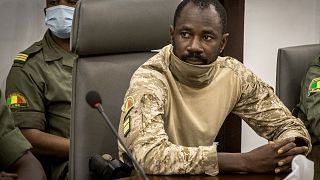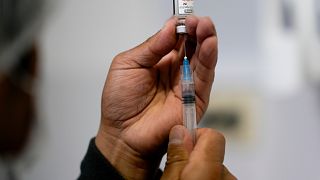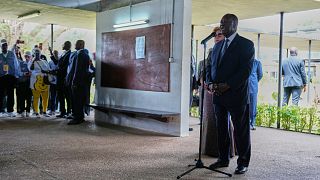USA
Howardena Pindell's Four Little Girls is a tribute to the young victims of a 1963 church bombing. The girls were killed by white supremacists.
This is just one of the brutal stories told through art at a new exhibition about violence against Black people.
The curator of "A Site of Struggle: American Art against Anti-Black Violence" wants to correct the misconception that anti-Black violence is a new thing.
"Artists have been engaging with this issue of anti-Black violence as long as it's been an issue within our country. I think art has a unique ability to get us to pause and to consider things that maybe we wouldn't be open to in a different context," says Janet Dees.
A new generation has been motivated by the current national reckoning on racial violence.
So organizers want to draw a line connecting the history of the subject.
"This exhibition would have been as relevant in 1992 as it would have been in 1962, as it would have been in 1922," said Lisa Corrin, the Director of Northwestern University's Block Museum of Art.
Modern acts of violence, like the killing of George Floyd, are all too fresh in the country's memory.
But works like Norman Lewis's watercolor Untitled (Police Beating), painted in 1943, show visitors that the problem is not a new one.
"There are a couple works in the exhibition that may seem as if they could have been created yesterday," says Dees.
The exhibition features approximately 65 works in a wide range of media from collections around the U.S.
It examines works by artists spanning more than 100 years, from the anti-lynching campaigns of the 1890s to the founding of the Black Lives Matter movement in 2013.
Dees has been studying anti-Black violence and art for more than a decade. It took six years for "A Site of Struggle: American Art against Anti-Black Violence," to come together.
It is divided into three sections, with each focused on different strategies artists use to explore issues of anti-Black violence.
One area focuses on abstraction and artists avoiding the literal representation of violence, a second is more figurative and the third uses literal representation of violence.
"There is so much material that could have been included in the exhibition, but it was important for me that we present a moderate number of works so that it would support the thesis of the exhibition, but not be unnecessarily overwhelming for visitors," says Dees.
The collaborative video artwork created by the Pope twins, Carl and Karen, has been included by Dees because of the profound impact it had on her after she saw it at the 2000 Whitney Biennial.
After not being seen in public for 20 years, the piece 'Palimpsest' shows Carl Pope's body being branded, incised and tattooed as his sister recites a poem.
Carl Pope used his body "as a writing surface," and Karen Pope's poetry to explore slavery and the scars left on Black bodies.
"It was a lot of discussion between the two of us and me encouraging him and me not totally understanding what he wanted to do, but I just felt that he was doing something important and that's all I needed to know," says Karen.
"To use my body as a writing surface and to have Karen speak with emotion the way she did about her own experiences in her own body as a Black person, it makes all of those things really hard for people to even understand why I would do something like that," says Carl.
"At first, visitors may find it difficult to look at because it does include video of three acts that the artist is having committed on his body," Dees says.
"But if you think about what these symbolic acts are referring to, you realize that what we're seeing is so much more tame in comparison to the actual violence that African-Americans have faced."
Knowing that many visitors may be impacted by the graphic nature of the exhibit, the designers have intentionally left quiet spaces for reflection as well as a research center for those who want to explore the subject more or even connect with civil rights activists.
"We also see this exhibition as a call to action. Each individual who sees the exhibition will have a different response and feel different things. And some people may want to know how they can help with change so that these acts of anti-Black violence we can we can break this cycle," says Corrin.
"A Site of Struggle: American Art against Anti-Black Violence," at the Mary and Leigh Block Museum of Art at Northwestern University, will be open until July 2022.
The exhibit will then travel to the Montgomery Museum of Fine Art in Alabama.












01:03
South Africa's DA party proposes axing race-based legislation
01:00
South Africa: Pig farm murder trial resumes in Polokwane court
01:22
Morocco reels in aftermath of violent clashes between protesters and police
00:41
Nighttime curfew imposed in Madagascar after violent service delivery protests
01:00
Japan cuts Africa exchange initiative amid increased immigration fears
01:01
South Africa reopens investigation into Steve Biko's death after 48 years